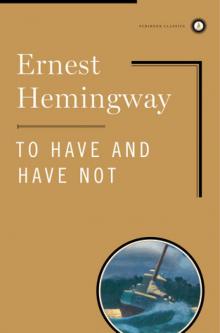- Home
- Ernest Hemingway
Dateline- Toronto Page 7
Dateline- Toronto Read online
Page 7
The United States Government report lists the various States where fox raising is practical and ranches have been started in localities as far separated as Idaho and Illinois. Thirty pairs of foxes were sold a few days ago in the States by one Prince Edward Island fox breeder. All were black foxes worth from $800 to $1,400 a pair. A number of fox-raising companies have been formed in Japan and about twenty-five pairs of silver foxes sent there.
Nearly all the silver fox ranches of Canada are in Prince Edward Island. The climate there is ideal for fur producing. The first ranch in Canada was started in 1902, but the industry was undeveloped until 1909, when a well-organized ranch was founded.
Silver fox farming as a get-rich scheme seized the public fancy and in 1912 and 1913 there was a flood of fake corporations formed to get the public’s sheckels. These companies put the silver fox game into disrepute, but meanwhile the legitimate ranchers were going ahead with their fox breeding. The war killed off the fake companies and the present-day fox ranchers are anything but conductors of stock-floating enterprises. At the apex of the boom as much as $18,000 was paid for a pair of breeding foxes. Now the prices rarely run over $1,500.
At present, however, the foxes are really being bred instead of appearing largely in prospectuses. In Prince Edward Island there are about 400 ranches and there are a half-dozen companies that are incorporated at from a half to a quarter of a million dollars.
Silver foxes start as accidents, or casuals, in a litter of red foxes, but they breed true to form. For instance, a red fox may have a silver fox among her cubs, but all the cubs of a silver fox will be silvers.
Fox ranchers only kill the poorest foxes for furs. For in spite of the fabulous prices paid for silver fox furs, with the new scope given the fox-ranching industry the foxes are worth much more to sell for breeding. Furs are graded according to quality and length of hair and fullness of the brush and are shipped to the St. Louis and London fur markets.
Eggs and milk are the principal articles of diet for the young foxes. The older ones are fed fox biscuits and skimmed milk, apples, rabbits and chickens and inspected horse meat.
One of the big problems of the fox ranchers is to prevent stealing. A few years ago there were organized gangs who ranged over the Island and raided the fox ranches. With a fox worth $1,400 as easy to steal as a pullet it was a better business than bank robbing.
Now every ranch has its armed watchman and a pack of bloodhounds. Someone is on guard night and day. In addition, each fox rancher has some system of marking his foxes so that he can positively identify them. These marks are usually branded on the pads of the feet or else the teeth are marked.
An organization of fox ranchers called the Prince Edward Island Fox Breeders’ Association is keeping the pedigrees of all silver foxes and standardizing the breeding. They also look after legislation that will help the ranchers.
Rum-Running
The Toronto Star Weekly
June 5, 1920
A man living in a small town in Iowa recently paid two hundred and fifty dollars a case for ten cases of Canadian whiskey. They were delivered by motortruck from Detroit. He has more ordered.
Canadian whiskey can be bought by the case from bootleggers in almost all of the Michigan border towns for one hundred and twenty dollars a case. Single quarts cost fifteen dollars. There is plenty of liquor and there are plenty of purchasers and the price seems to be no deterrent.
It is no wonder that the question that is most often asked of an American returning to the States from Canada is, “How long are they going to be able to ship grog out of Canada?”
There is both organized and unorganized rum-running across the border on an unbelievably large scale. Fortunes are being made by the bootleggers who have the liquor shipped to their carefully established residences at Windsor and nearby towns, and then run it across the river to the States. That short trip across the river is one of the most expensive in the world. A case of whiskey, which retails at forty-eight dollars in Windsor, is ferried over to the United States side in a skiff—but as soon as it touches the alien shore its minimum value is automatically one hundred and twenty dollars.
On the train from Toronto to Windsor, I talked with a man who was bringing twenty cases of whiskey to Windsor. He estimated that his profits on the liquor when it was deposited on the United States side would be fourteen hundred and fifty dollars.
“It’s a little risk,” he said. “We run it all at night in small boats. The revenue agents have motorboat patrols, but we keep out of their way pretty well.”
According to this bootlegger the recent story about the electrical torpedo which was said to be shot from Canada to the United States filled with liquor is a pipe dream of some overworked newspaperman. “It is either a straight newspaper fake or else the revenue men started this yarn,” declared this man, who ought to know. “There is so much booze coming into Detroit that the revenue gang have to have an alibi somewhere, so they may have framed the torpedo story.”
Another bootlegger in Detroit quizzed me about the length of time the importation of liquor between the provinces would be allowed.
“I’m afraid of that referendum. The farmers are liable to cut us off. But if we can have six months more of this, even if I get pinched a couple of times, I’ll be able to retire.”
All the rum-running is not confined to the cities. You hear tales of lonely shacks along the rocky north shore of Lake Superior, where hundreds of cases of whiskey are stored. You hear of the trapper who invested the savings of a lifetime in liquor that he plans to smuggle into the States this summer. You hear stories of Mackinaw boats manned by Ojibway Indians from around the Garden River district, which stop in at Upper Peninsula [Michigan] ports after dark and are gone in the morning.
You hear of cities like Grand Marais in Upper Michigan, which have been dead for twenty years, that are now coming back to a furtive, silent existence since the passage of the Eighteenth Amendment.
In the cities you see the evidences that there is a liquor traffic between Canada and the States. I saw a slack-lipped, white-faced kid being supported on either side by two scared-looking boys of his own age in an alley outside a theater in Detroit. His face was pasty and his eyes stared unseeingly. He was deathly sick, his arms hanging loosely.
“Where’d he get it?” I asked one of the scared kids.
“Blew in his week’s pay for a quart of Canuck bootlegged.” The two boys hauled him up the alley. “Come on, we got to get him out of here before the cops see him.”
If the people who talk about “good liquor” could see a kid drunk—but this isn’t a sermon. It is merely a few facts on the way liquor is coming into the United States from Canada.
It is coming in in large quantities in as widely divergent places as New York City and Minneapolis. The other day in New York a schooner from Halifax successfully smuggled in enough liquor to make the owner a fortune. Twenty-five dollars a quart is the price for the cheapest whiskey in New York.
There is a long unguarded frontier between Canada and the States and as long as liquor is allowed to be shipped to border provinces that are supposed to be dry it will find its way into the States. What interests the people of the States, both bootleggers and the people who voted the States dry, is how long is the liquor going to come in? They are watching for the result of Ontario’s referendum on prohibition.
The Hamilton Gag
The Toronto Star Weekly
June 12, 1920
If you are a regular attendant at the theaters of Toronto you always go to a musical show with a calm mind. You may not know the tunes. The lyrics may be new to you. It may be the first time that you have seen the principals. But your mind is calm and quiet. Sooner or later you know that you will hear it. Before the evening is over you are confident it will make its appearance. It always does.
It is the thousand-time perpetrated Toronto-Hamilton gag. Usually it comes out like this.
First Comedian: “Do you live in the
city?”
Second Comedian, hitting him across the face with a sausage so the audience will not forget that he is a comedian: “No, I live in Hamilton!”
Always someone laughs heartily. Look at the laugher. Mark him well. He may be a distinguished visitor from foreign parts. One thing at least is certain: it is his first time at a musical show in Toronto.
Of course twenty years ago native Torontonians probably laughed when the jest was first pulled. It is their fault. For a tradition has evidently been established in the profession that to ensure success to their patter it should contain some reference to Toronto and Hamilton.
It may have been funny at first. There might be certain funny aspects of the seizure by infantile paralysis of a neighbor’s child. But why refer to it year after year? There must be other local things that could be utilized as jokes instead of eternally inflicting the Hamiltonian tragedy on the theatergoer.
The essence of true comedy as observed at the shows that have appeared here this season seems to be to inflict severe physical suffering on one or both of the comedians. Any fat man falling down anywhere is good for a laugh. If a fat man falls into a tub of water, the applause is tremendous. The fatter the man and the larger the amount of water he falls into the greater the humor of the situation.
Working on that principle, if it could be arranged to have a really enormous fat man drowned in an ocean, the production staging the spectacle would be assured of success. It would be the comedy triumph of the age.
Any vaudeville team act in which the feminine half constantly slaps and smacks the masculine half in the face is a riot. In a recent act at a local vaudeville house neither the man nor girl could sing or dance well enough to earn even a ripple of applause. By dint of the girl’s constant slappage of her partner’s countenance, the house was soon in an uproar and the act was an immense hit.
Combining this principle of comic violence with some really snappy local dialogue, visiting comedians should be able to add the desired “hometown” stuff to their performance without employing the haggard old Hamilton wheeze.
These are offered as suggestions to any members of either voadveel or the legit who care to make use of them:
This would be very funny:
First Comedian: “Have you a mayor here?”
Second Comedian: “Ha, haw!”
First comedian then hits second comedian with a chair, knocking him over the footlights into the audience. Cheer after cheer rocks the house.
Or they might employ more subtle stuff like this:
First Comedian, shooting second in the back: “Did you hear about the new man working on the new Union Station?”
Second Comedian, knocking his teeth out with a blackjack: “Oh, the other man got lonesome!”
It is very easy. Anyone can do it with a little practice. There are two jokes. One will be good until a change of administration and the other until the station is finished. All comedians are quite welcome to them. By the time they are too old I will have thought of a couple more. But let us bury the Hamilton joke.
Camping Out
The Toronto Star Weekly
June 26, 1920
Thousands of people will go into the bush this summer to cut the high cost of living. A man who gets his two weeks salary while he is on vacation should be able to put those two weeks in fishing and camping and be able to save one week’s salary clear. He ought to be able to sleep comfortably every night, to eat well every day and to return to the city rested and in good condition.
But if he goes into the woods with a frying pan, an ignorance of black flies and mosquitoes, and a great and abiding lack of knowledge about cookery, the chances are that his return will be very different. He will come back with enough mosquito bites to make the back of his neck look like a relief map of the Caucasus. His digestion will be wrecked after a valiant battle to assimilate half-cooked or charred grub. And he won’t have had a decent night’s sleep while he has been gone.
He will solemnly raise his right hand and inform you that he has joined the grand army of never-agains. The call of the wild may be all right, but it’s a dog’s life. He’s heard the call of the tame with both ears. Waiter, bring him an order of milk toast.
In the first place he overlooked the insects. Black flies, no-seeums, deer flies, gnats and mosquitoes were instituted by the devil to force people to live in cities where he could get at them better. If it weren’t for them everybody would live in the bush and he would be out of work. It was a rather successful invention.
But there are lots of dopes that will counteract the pests. The simplest perhaps is oil of citronella. Two bits’ worth of this purchased at any pharmacist’s will be enough to last for two weeks in the worst fly- and mosquito-ridden country.
Rub a little on the back of your neck, your forehead and your wrists before you start fishing, and the blacks and skeeters will shun you. The odor of citronella is not offensive to people. It smells like gun oil. But the bugs do hate it.
Oil of pennyroyal and eucalyptol are also much hated by mosquitoes, and with citronella they form the basis for many proprietary preparations. But it is cheaper and better to buy the straight citronella. Put a little on the mosquito netting that covers the front of your pup tent or canoe tent at night, and you won’t be bothered.
To be really rested and get any benefit out of a vacation a man must get a good night’s sleep every night. The first requisite for this is to have plenty of cover. It is twice as cold as you expect it will be in the bush four nights out of five, and a good plan is to take just double the bedding that you think you will need. An old quilt that you can wrap up in is as warm as two blankets.
Nearly all outdoor writers rhapsodize over the browse bed. It is all right for the man who knows how to make one and has plenty of time. But in a succession of one-night camps on a canoe trip all you need is level ground for your tent floor and you will sleep all right if you have plenty of covers under you. Take twice as much cover as you think that you will need, and then put two-thirds of it under you. You will sleep warm and get your rest.
When it is clear weather you don’t need to pitch your tent if you are only stopping for the night. Drive four stakes at the head of your made-up bed and drape your mosquito bar over that, then you can sleep like a log and laugh at the mosquitoes.
Outside of insects and bum sleeping, the rock that wrecks most camping trips is cooking. The average tyro’s idea of cooking is to fry everything and fry it good and plenty. Now, a frying pan is a most necessary thing to any trip, but you also need the old stew kettle and the folding reflector baker.
A pan of fried trout can’t be bettered and they don’t cost any more than ever. But there is a good and bad way of frying them.
The beginner puts his trout and his bacon in and over a brightly burning fire the bacon curls up and dries into a dry tasteless cinder and the trout is burned outside while it is still raw inside. He eats them and it is all right if he is only out for the day and going home to a good meal at night. But if he is going to face more trout and bacon the next morning and other equally well-cooked dishes for the remainder of two weeks, he is on the pathway to nervous dyspepsia.
The proper way is to cook over coals. Have several cans of Crisco or Cotosuet or one of the vegetable shortenings along that are as good as lard and excellent for all kinds of shortening. Put the bacon in and when it is about half cooked lay the trout in the hot grease, dipping them in cornmeal first. Then put the bacon on top of the trout and it will baste them as it slowly cooks.
The coffee can be boiling at the same time and in a smaller skillet pancakes being made that are satisfying the other campers while they are waiting for the trout.
With the prepared pancake flours you take a cupful of pancake flour and add a cup of water. Mix the water and flour and as soon as the lumps are out it is ready for cooking. Have the skillet hot and keep it well greased. Drop the batter in and as soon as it is done on one side loosen it in the skillet and flip it o
ver. Apple butter, syrup or cinnamon and sugar go well with the cakes.
While the crowd have taken the edge from their appetites with flapjacks, the trout have been cooked and they and the bacon are ready to serve. The trout are crisp outside and firm and pink inside and the bacon is well done—but not too done. If there is anything better than that combination the writer has yet to taste it in a lifetime devoted largely and studiously to eating.
The stew kettle will cook you dried apricots when they have resumed their predried plumpness after a night of soaking, it will serve to concoct a mulligan in, and it will cook macaroni. When you are not using it, it should be boiling water for the dishes.
In the baker, mere man comes into his own, for he can make a pie that to his bush appetite will have it all over the product that mother used to make, like a tent. Men have always believed that there was something mysterious and difficult about making a pie. Here is a great secret. There is nothing to it. We’ve been kidded for years. Any man of average office intelligence can make at least as good a pie as his wife.
All there is to a pie is a cup and a half of flour, one-half teaspoonful of salt, one-half cup of lard and cold water. That will make piecrust that will bring tears of joy into your camping partner’s eyes.
Mix the salt with the flour, work the lard into the flour, make it up into a good workmanlike dough with cold water. Spread some flour on the back of a box or something flat, and pat the dough around a while. Then roll it out with whatever kind of round bottle you prefer. Put a little more lard on the surface of the sheet of dough and then slosh a little flour on and roll it up and then roll it out again with the bottle.
Cut out a piece of the rolled-out dough big enough to line a pie tin. I like the kind with holes in the bottom. Then put in your dried apples that have soaked all night and been sweetened, or your apricots, or your blueberries, and then take another sheet of the dough and drape it gracefully over the top, soldering it down at the edges with your fingers. Cut a couple of slits in the top dough sheet and prick it a few times with a fork in an artistic manner.

 The Old Man and the Sea
The Old Man and the Sea Green Hills of Africa
Green Hills of Africa The Sun Also Rises
The Sun Also Rises Death in the Afternoon
Death in the Afternoon In Our Time
In Our Time For Whom the Bell Tolls
For Whom the Bell Tolls A Farewell to Arms
A Farewell to Arms A Moveable Feast
A Moveable Feast The Complete Short Stories of Ernest Hemingway
The Complete Short Stories of Ernest Hemingway Big Two-Hearted River
Big Two-Hearted River Winner Take Nothing
Winner Take Nothing Islands in the Stream
Islands in the Stream To Have and Have Not
To Have and Have Not The Snows of Kilimanjaro and Other Stories
The Snows of Kilimanjaro and Other Stories Across the River and Into the Trees
Across the River and Into the Trees By-Line Ernest Hemingway
By-Line Ernest Hemingway True at First Light
True at First Light Men Without Women
Men Without Women The Nick Adams Stories
The Nick Adams Stories Dateline- Toronto
Dateline- Toronto The Torrents of Spring
The Torrents of Spring Short Stories
Short Stories